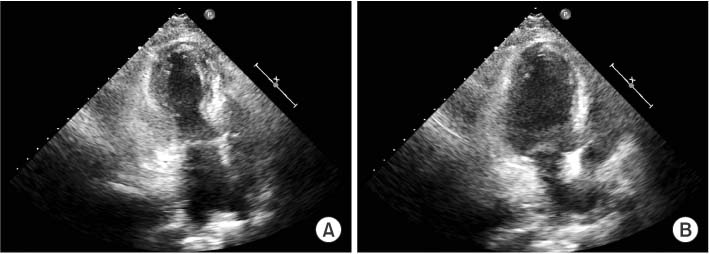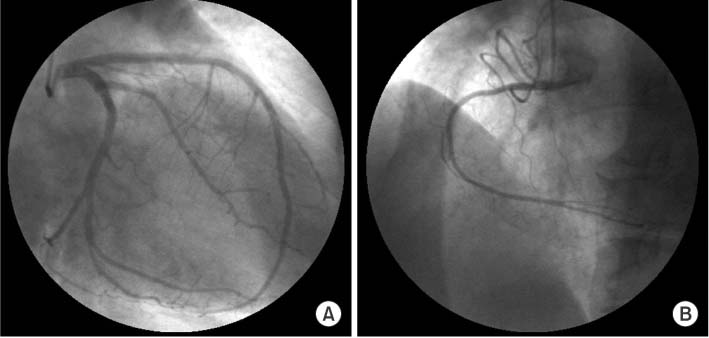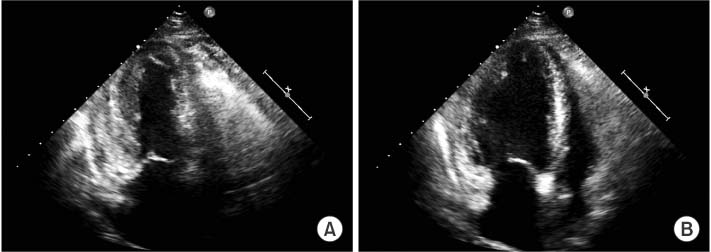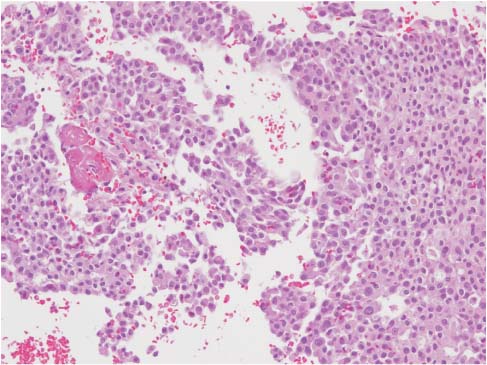Ewha Med J.
2015 Jul;38(2):90-93. 10.12771/emj.2015.38.2.90.
Stress-induced Cardiomyopathy Associated with Non-Small Cell Lung Cancer Presenting as Hyponatremia
- Affiliations
-
- 1Division of Cardiology, Department of Internal Medicine, Kwangju Christian Hospital, Gwangju, Korea. kdgsmile@hanmail.net
- KMID: 2052788
- DOI: http://doi.org/10.12771/emj.2015.38.2.90
Abstract
- Stress-induced cardiomyopathy, so-called Takotsubo cardiomyopathy, has recently been reported in Japan. Stress-induced cardiomyopathy is characterized by transient left ventricular apical dysfunction and ballooning, with normal coronary angiographic findings. We describe a rare case of stress-induced cardiomyopathy associated with lung adenocarcinoma presenting as hyponatremia.
Keyword
MeSH Terms
Figure
Reference
-
1. Dote K, Sato H, Tateishi H, Uchida T, Ishihara M. Myocardial stunning due to simultaneous multivessel coronary spasms: a review of 5 cases. J Cardiol. 1991; 21:203–214.2. Wittstein IS, Thiemann DR, Lima JA, Baughman KL, Schulman SP, Gerstenblith G, et al. Neurohumoral features of myocardial stunning due to sudden emotional stress. N Engl J Med. 2005; 352:539–548.3. Kawai S, Suzuki H, Yamaguchi H, Tanaka K, Sawada H, Aizawa T, et al. Ampulla cardiomyopathy ('Takotusbo' cardiomyopathy): reversible left ventricular dysfunction: with ST segment elevation. Jpn Circ J. 2000; 64:156–159.4. Lee HH, Gwon HC, Kim BJ, Lee KJ, Im ES, Won KH, et al. Clinical manifestation of novel stress-induced cardiomyopathy mimicking acute myocardial infarction: single center prospective registry. Korean Circ J. 2002; 32:1054–1063.5. Andrade AA, Stainback RF. Takotsubo cardiomyopathy. Tex Heart Inst J. 2014; 41:299–303.6. Donohue D, Movahed MR. Clinical characteristics, demographics and prognosis of transient left ventricular apical ballooning syndrome. Heart Fail Rev. 2005; 10:311–316.7. McDonald P, Lane C, Rojas GE, Masood A. Syndrome of inappropriate anti-diuretic hormone in non-small cell lung carcinoma: a case report. Ecancermedicalscience. 2012; 6:279.8. Vanhees SL, Paridaens R, Vansteenkiste JF. Syndrome of inappropriate antidiuretic hormone associated with chemotherapyinduced tumour lysis in small-cell lung cancer: case report and literature review. Ann Oncol. 2000; 11:1061–1065.9. Sorensen JB, Andersen MK, Hansen HH. Syndrome of inappropriate secretion of antidiuretic hormone (SIADH) in malignant disease. J Intern Med. 1995; 238:97–110.10. Bose CK, Dey S, Mukhopadhyay A. Hyponatremia of non-small cell lung cancer: Indian experience. Indian J Med Paediatr Oncol. 2011; 32:139–142.
- Full Text Links
- Actions
-
Cited
- CITED
-
- Close
- Share
- Similar articles
-
- Stress-induced Cardiomyopathy during Pulmonary Resection (Takotsubo Syndrome): A case report
- Small cell neuroendocrine carcinoma of the uterine cervix presenting with syndrome of inappropriate antidiuretic hormone secretion
- A case of SIADH in small cell lung cancer
- Recurrent fetal postpartum stress induced cardiomyopathy after normal vaginal delivery
- A case of stress-induced cardiomyopathy with an "inverted Takotsubo" contractile pattern







